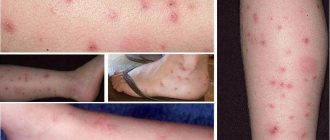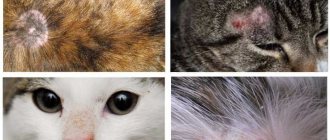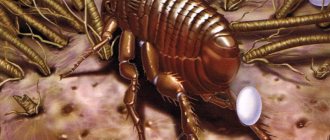White specks in an animal's fur may mean there are fleas. The cause of infection is walking in the open air, unsanitary conditions of living quarters, contact with other animals and rodents. In case of infection, a number of measures must be taken to treat the cat and the premises. It is not difficult to remove bloodsuckers; the market offers a wide selection of drugs for this purpose.
Reasons for appearance
The owner notices that when the pet itches, white grains fall off the fur. Black microscopic formations similar to dots fall along with them. These are flea testicles mixed with adult excrement. Infection with parasites in cats is seasonal and occurs in the warm season. The reasons are walks in the open air, contact with infected animals and rodents, and insufficiently good sanitary condition of the room where the cat lives.
The black and white colors of the mixture of eggs and droppings resemble gray dust, which is difficult to confuse with anything else.
Ascariasis
But if a cat has white worms, this does not mean at all that we are talking about cestodes. It is quite possible that these are parasitic nematodes, that is, parasitic round worms. Let us emphasize once again that these worms are rarely found in feces. They, unlike cestodes, have a “fused” body, there is no segmentation, and therefore no segments are torn off. Secondly, they move very actively in the lumen of the small intestines, and therefore do not enter the feces. The exception is a particularly severe attack of diarrhea or the death of parasites from natural or “medicinal” causes.
Diagnostic methods
No special laboratory methods are required to detect fleas. A simple visual observation proves that the cat has skin parasites in the initial stage. To understand the method of fighting them, you need to understand what fleas are, what stages of their development, where they live and what they eat. The table will help with this:
| Stage | Appearance | Nutrition | Location |
| Egg | Grain 0.5 mm | Adult droppings that look like a black dot | On wool and in the environment |
| Larva | Yellow worms 6 mm long | Dead epithelium, food debris, flea secretions | In dark places |
| Pupae | Sticky formations with a protective cocoon | Internal resources | In hard to reach places |
| Adult insect | Oblong black body up to 4 mm long | Cat's blood | In animal fur and in the external environment |
Return to contents
Allergies
Allergies are usually caused by parasites. Symptoms: baldness in certain areas, itching, spots of different colors. The allergy will go away after eliminating the fleas after 5-6 weeks.
Also, allergies can be due to external irritants and food. Treatment in this case becomes more complicated because identifying the allergen is not easy. Shampoos with hydrocortisone work well as local antiallergic agents.
They give an immediate but short-term effect. Hydrocortisone ointments are used when pets have itching. They are applied to small areas that are inaccessible for licking.
Solution
Therapy against parasites consists of several stages:
- Bathing a cat with special shampoos. This step is mandatory. Recommendations on the choice of product can be given by a veterinarian.
- Treating the animal with flea drops, usually applied to the withers.
- Wearing a collar. Its task is to repel parasites. The collar lasts on average up to six months.
- The remaining eggs or adults should be destroyed, for which the animal’s sleeping place is sprayed with anti-parasite sprays, and the bedding is washed.
- Carry out a general cleaning of the house, thoroughly shake out sand from carpets, vacuum mattresses and curtains, and, if possible, wash them.
Return to contents
Prevention
It is important to prevent flea infestations. To do this you need:
- Clean, wash, dry and hide shoes immediately upon returning from the street.
- Keep your living space clean and carry out wet cleaning regularly.
- Wash curtains and vacuum carpets at least once a month.
- Change bed linen weekly.
- Prevent rodents from entering the house.
- Examine your cat thoroughly every week. In this case, you should pay attention to the skin - it must be clean.
Return to contents
Features of cat therapy
It is important to remember that many of the proposed insecticidal preparations are effective against adults, but are harmless for eggs, larvae and pupae. A flea comb does not allow you to comb out all the parasites. A complex treatment of fleas is used using oral medications, for example, Program. It is given to the cat once a month. Once in the flea's body with the blood, it prevents the eggs from hatching. The choice of pharmaceutical drug should be entrusted to a veterinarian, especially if the female is pregnant. In addition, each medicine is designed for a specific type of parasite. Dog drops will not be effective against cat fleas; they still remain in the fur.
Animal diseases » Cats »
Cats are sensitive creatures. Any change in the nature of nutrition, care and living conditions can negatively affect their condition. Most often, skin diseases appear. They can be caused by infection, bacteria, parasites and insects. In addition, there are a large number of congenital pathologies in which cats develop problems with the skin.
All changes on the skin refer to the unifying term - dermatitis. In this case, itching, flaking, changes in behavior in cats, as well as deterioration in their appearance may be observed. But still, the main symptoms and treatment directly depend only on what exactly caused the pathology, that is, on their cause.
Eczema
Eczema is an unpredictable disease.
Appears due to many factors, including:
- Severe skin contamination with parasites, dirt, bacteria;
- Improper wearing of collars and synthetic clothing for cats;
- Complication of any disease (pathology of the nervous system, kidney disease, stomach and liver).
The main symptom is a weeping surface of the skin. Scratching causes knots and redness to form. The cat is rapidly losing weight, has a fever and kidney problems.
For diagnostic purposes, the veterinarian will take a skin scraping to rule out the possibility of other diseases. Afterwards he should prescribe antihistamines. You should not try to treat your cat without a doctor, as complications may develop.
Fungal pathologies
The main sign of a fungal infection is the appearance of a bald area covered with scales. The skin in the area of the ears, head and paws is most often affected. As the disease progresses, the process can spread over large areas, covering more than 50% of the body with crusts and scales.
Treatment of the disease is aimed at removing the fungus from the animal’s body. In this case, the choice of drugs depends on the pathogen itself. If ringworm is present, Lamisil is used. In this case, only topical products such as a spray or ointment should be used. Oral administration of the drug gives practically no results.
Veterinarians often prescribe Mycofit. These baths are especially effective for extensive lesions, as they allow you to treat the entire surface of the skin. In the presence of yeast fungi, which can begin to multiply with a pronounced decrease in immunity, nystatin, probiotics, miconazole, and so on should be used. In this case, treatment of the disease should be carried out not only locally, but also internally, since most often the mucous membranes and the inner surface of the organs are simultaneously affected.
Prevention of fungal pathologies in cats is important. First of all, this is vaccination. Also, if there is a risk of fungal infection, bathing with the addition of Mycophyte is used. Hygiene of the premises where the animal is located is mandatory.
Ectoparasitic diseases
This is perhaps the most common cause of dermatitis. As a rule, they are all accompanied by severe itching. As a result, scratch marks appear. When an infection occurs, more serious skin pathologies may develop.
Identifying ectoparasitic diseases in cats is quite simple. During a visual inspection, fleas and their metabolic products are identified. It should be noted that fleas on cats are different from dog fleas. You can verify this by looking at the photo. In addition, parasites such as lice, mites and cheyletella or grass mites can be detected.
All diseases caused by ectoparasites are accompanied by symptoms such as severe itching and redness of the bite sites. In addition, some of them can cause symptoms of infectious diseases that are carried by blood-sucking parasites.
The cause or type of ectoparasite can be determined by the bite. To do this, you should also carefully examine the skin and find the site of the bite. Next, it is enough to compare them with the photo and identify the ectoparasite that caused the damage. If these measures do not produce results, you should see a veterinarian, who will scrape the skin and determine the causative agent of the disease.
Treatment of the disease is carried out using drugs that help remove ectoparasites from wool. The wool is treated several times at intervals, the duration of which depends on the chosen preparation. In addition, it is necessary to treat the area where the pet lives. For preventive purposes, all animals in the house should be treated.
Ear mites
Ear mites appear as a result of improper care. Symptoms: scratching, foul odor from the ears, dark gray discharge, redness of the skin of the ears, fever.
Treatment can begin after visiting a veterinarian. Various aerosols (based on Dermatosol or Tsiodrin), drops (Bars, Tsipam, Amitrazine) and ointments (Nicochloran, Phenothiazine) are used. Dark discharge should be removed with a soft cotton cloth or cotton wool.
Allergic dermatitis
Allergic diseases are often disguised as skin pathologies. They are also accompanied by itching and rash. But at the same time, the reason for their appearance is poor nutrition, the use of vitamins, cosmetics, and so on. In addition, itching is often caused by animal contact with house plants, household chemicals, medications and other allergens. Short-haired and light-colored cats may be intolerant of sunlight. It also manifests itself in the appearance of scales on the skin with mild itching.
Before looking for treatment for the disease, all of the above pathologies should be excluded. Only after this the allergen is identified. Depending on what specific symptoms of the disease are present, one or another drug is used. Antihistamines, ointments that relieve itching and anti-inflammatory drugs are mandatory.
If the allergy is caused by food, you should work with your veterinarian to select the most suitable food for your cat, taking into account its characteristics and health status.
Particularly noteworthy is such a pathology as atopic miliary dermatitis. This disease is associated with the body's hyperreaction to an allergen. At the same time, skin manifestations can occur even from contact with street grass, if there is an odor in the room, if the diet is changed, that is, in situations in which a healthy cat will not have any reaction. In the photo, such manifestations look like pinpoint bites, scratches, and scales. Treatment is aimed at reducing the body's reaction. Antihistamines and drugs to strengthen the immune system are prescribed.
Pathologies associated with hair
Skin diseases can be accompanied by hair loss in cats. In this case, pathologies can be congenital and acquired. The first are observed in certain breeds of animals. In this case, there may be a complete absence of wool or its pronounced rarity. In addition, there is a disease such as hypotrichosis. In this case, animals lose hair at the age of 6 months and do not grow back. This is a hereditary pathology that cannot be treated.
Acquired ones include severe shedding. With this pathology, there are symptoms such as severe hair loss during shedding. In the intervals between these periods, wool also falls out, but in smaller quantities. In the photo, such cats look unkempt and have sparse fur.
Sometimes skin diseases occur with hair loss in the ears and eyes. However, this condition is not a pathology. It is most common in short-haired cats and does not require treatment.
Psychological illnesses in cats can also lead to baldness. Careful licking of the fur can lead to hair loss. Treatment of the disease is accompanied by the use of tranquilizers and the creation of conditions that eliminate stress.
In addition to all of the above, hair loss can be caused by skin trauma, skin parasites, systemic diseases, kidney and liver diseases, as well as digestive organs. All of them must be correctly diagnosed in order to carry out effective treatment, since some diseases are dangerous and can be fatal.
Tail gland hyperplasia
If the tail gland has increased hyperplasia, excessive accumulation of sebaceous secretion appears. It is released and envelops the hair at the point of growth, blocking its further development. Because of this, her hair falls out and areas of baldness appear.
Therapy involves monitoring the problem area. Castration can help cats.
Viral infections
Diseases caused by a virus are rare, but still occur. This could be leukemia, immunodeficiency, herpes. In this case, in addition to skin damage, as a rule, there is a violation of the integrity of the mucous membranes and the involvement of internal organs in the pathological process.
Pathology can often be determined from a photo. For example, herpes has characteristic rashes, and calicivirus is manifested by damage to the paw pads, which is clearly visible in the photo. They all need to be treated, and throughout their lives. The main focus is improving immunity.
Loading …
Even experienced cat owners cannot always boast of an excellent knowledge of all the ailments that can happen to a pet. What can we say, only a veterinarian can know everything. Careful owners can only pay attention to their furry pet in a timely manner and not leave seemingly minor changes unattended.
White grains (microscopic balls)
White specks on cats' fur can only be noticed upon careful inspection.
One of the strange manifestations of cat malaise is white grains or microscopic balls that fall off the animal’s fur. They are not noticed immediately. At first, they only evoke puzzled glances from the owner and a silent question in his eyes. Where do the mysterious grains come from and what are they?
Why do cats have white specks in their fur?
Dirty shoes can cause fleas in your cat.
The reason for the appearance of white specks (flea eggs) may be a banal walk on the street or shoes on which the owner could bring parasites from the street. In this case, one can only sympathize. And speaking about cats walking through the streets, a lot has already been said. It is not recommended to let an animal go out on its own for a variety of reasons, and parasites are one of them.
If you have a strong desire to give your mustachioed friend fresh air, there are carriers for this. You can put your cat in it and safely walk with it outside. All other methods are fraught with danger to the health of the animal.
Acne
Acne can appear due to improper care of your pet, severe stress and emotional distress. Acne can develop into pustules and ulcers, which cause severe pain for your pet and sometimes lead to inflammation.
A complication of acne is folliculitis. It is a swelling around the hair, usually with liquid contents. When touched, the pet experiences pain.
Self-medication and squeezing pimples are not recommended. You can treat rashes with tar soap or shampoo.
Getting rid of the source of white grains
Having discovered suspicious balls on the cat’s fur or in its places of residence, you must immediately begin anti-parasitic therapy:
- First of all, the cat needs to be bathed using special shampoos . It is better to choose the most effective one. Advice on choosing can be given by a veterinarian or a consultant at a pet supply store. If your cat resists bathing, you need to force her.
Bathe your cat only with special shampoos.
- Next, you need to treat the cat with flea drops , which are applied to the withers.
Flea drops for cats are very effective.
- The next step should be a flea collar .
Thanks to special impregnation, the collar repels fleas.
Many limit themselves to drops and ignore collars. Meanwhile, they represent a very powerful defense option. A classic flea collar is impregnated with a special substance that repels fleas. The action continues for 6 months.
Grains, i.e. Flea eggs appear after adult fleas have settled on the body; they lay their offspring.
Consolidate the result
You should pay attention not only to your pet’s hygiene, but also to the cleanliness of its bed or house.
After treating the cat, you should take care of the living space. There are probably eggs left in the apartment that have fallen from the cat’s fur. They can lie unnoticed for a long time until adult fleas hatch from them.
The cat's bed or house must be washed and treated with parasite spray.
All carpets, mattresses, soft toys and bedding should be thoroughly washed and vacuumed. This point should not be missed, otherwise all the cat’s treatment will be in vain.
In addition to the actions taken, a visit to the doctor would be useful. He will examine the animal's body and may find painful scratches on the skin from flea bites. You can do this yourself. But the specialist will give all the necessary recommendations.
Preventive measures
It is important to take action at the slightest suspicion of fleas in a cat.
No cat is immune from parasites. However, you can keep your pet as safe as possible. Outdoor shoes must be thoroughly washed and stored in a closed closet. But it would also be a good idea to negotiate with your neighbors in the entrance and call a service that will treat the stairwells, garbage chute and basement for fleas. They can be carried by rats.
And of course, it is necessary to have your cat examined at least several times a month. The fur needs to be spread apart so that the skin is visible. A healthy purr is always clean.
Where to look for flea larvae in an apartment or house?
Flea larvae usually stay where they have direct access to food and can be found in comfortable climatic conditions - in garbage, secluded warm places, in animal cages - in the toilet and under beds. In nature - in the nests and burrows of mammals and birds.
In apartments and houses, flea larvae should be looked for primarily in places where cats, dogs and other pets live and are kept, in heaps of garbage in pantries and closets, among stocks of old grocery products.
In garden plots, chicken coops and animal keeping areas, flea larvae live directly in the litter and dried droppings. It is under the layer of garbage and droppings in the same chicken coop that flea larvae sometimes swarm literally in the thousands.
However, you can also find flea larvae in completely unexpected places - in vases with flowers, under trash cans, in a box in which vegetables are stored. It is important to understand that they do not start here on their own, and you should look for them only when adult fleas were found in the apartment.
The photo below shows a flea larva under a microscope - you can easily correlate its size with the thickness of a cat's hair:











